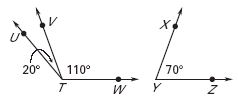Complementary or Supplementary
To determine whether an angle pair is complementary or supplementary you have to recall the definition of complementary and supplementary.
Complementary - two angles whose sum is 90°
Supplementary - two angles whose sum is 180°
Example 1
Identify a pair of complementary and supplementary angles.
m 1 = 40°
1 = 40°
m 2 = 140°
2 = 140°
m 3 = 50°
3 = 50°
m 1 + m
1 + m  3 = 90° therefore 1 and 3 are complementary.
3 = 90° therefore 1 and 3 are complementary.
m 1 + m 2 = 180° therefore 1 and 2 are supplementary.
Example 2: Determine if angles POQ and ROS are complementary or supplementary.
 m
m  POQ is 55°
POQ is 55°
m ROS is 35°
ROS is 35°
55° + 35° = 90° Therefore the angles are complementary.
Example 3: Identify a pair of complementary and a pair of supplementary angles.

m UTV is 20°
UTV is 20°
m VTW is 110°
VTW is 110°
m XYZ is 70°
XYZ is 70°
m UTV + m
UTV + m  XYZ = 20° + 70° = 90°
XYZ = 20° + 70° = 90°
 UTV and
UTV and  XYZ are complementary
XYZ are complementary
m VTW + m
VTW + m  XYZ = 110° + 70° = 180°
XYZ = 110° + 70° = 180°  VTW and
VTW and  XYZ are supplementary
XYZ are supplementary
Example 4: Identify a pair of complementary and a pair of supplementary angles.

 3 +
3 +  4 = 90°
4 = 90°
 1 +
1 +  2 = 90° + 90° = 180°
2 = 90° + 90° = 180°
Quick Summary:
There are two methods to determining if an angle pair is complementary: (1) if you are looking at a diagram you will be looking for two adjacent angles that form a right angle.
(2) you can add the measure of any two angles and see if their sum is 90°.
There are two methods to determining if an angle pair is supplementary: (1) if you are looking at a diagram you will be looking for two adjacent angles that form a linear pair.
(2) you can add the measure of any two angles and see if their sum is 180°.
Complementary - two angles whose sum is 90°
Supplementary - two angles whose sum is 180°
Example 1
Identify a pair of complementary and supplementary angles.
m
 1 = 40°
1 = 40°m
 2 = 140°
2 = 140°m
 3 = 50°
3 = 50°m
 1 + m
1 + m  3 = 90° therefore 1 and 3 are complementary.
3 = 90° therefore 1 and 3 are complementary.m 1 + m 2 = 180° therefore 1 and 2 are supplementary.
Example 2: Determine if angles POQ and ROS are complementary or supplementary.
 m
m  POQ is 55°
POQ is 55° m
 ROS is 35°
ROS is 35°
55° + 35° = 90° Therefore the angles are complementary.
Example 3: Identify a pair of complementary and a pair of supplementary angles.

m
 UTV is 20°
UTV is 20°m
 VTW is 110°
VTW is 110°m
 XYZ is 70°
XYZ is 70°m
 UTV + m
UTV + m  XYZ = 20° + 70° = 90°
XYZ = 20° + 70° = 90°
 UTV and
UTV and  XYZ are complementary
XYZ are complementarym
 VTW + m
VTW + m  XYZ = 110° + 70° = 180°
XYZ = 110° + 70° = 180°  VTW and
VTW and  XYZ are supplementary
XYZ are supplementaryExample 4: Identify a pair of complementary and a pair of supplementary angles.

-
 3 and
3 and  4 form a right angle. A right angle is 90° therefore they are complementary.
4 form a right angle. A right angle is 90° therefore they are complementary.
 3 +
3 +  4 = 90°
4 = 90°-
 1 and
1 and  2 are a linear pair which means they are supplementary. m
2 are a linear pair which means they are supplementary. m  1 = 90° and m
1 = 90° and m  2 = 90°
2 = 90°
 1 +
1 +  2 = 90° + 90° = 180°
2 = 90° + 90° = 180°Quick Summary:
There are two methods to determining if an angle pair is complementary: (1) if you are looking at a diagram you will be looking for two adjacent angles that form a right angle.
(2) you can add the measure of any two angles and see if their sum is 90°.
There are two methods to determining if an angle pair is supplementary: (1) if you are looking at a diagram you will be looking for two adjacent angles that form a linear pair.
(2) you can add the measure of any two angles and see if their sum is 180°.
|
Related Links: Math Geometry Topics Polygons Supplementary Angles |
To link to this Complementary or Supplementary page, copy the following code to your site:
